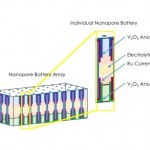 Shalini Saxena We’re increasingly dependent upon our batteries, so finding ways of building ones with enhanced lifetimes would make a lot of people happy. Research on batteries has ranged from trying new materials to changing the configuration of key components. Now, researchers have managed to restructure the materials in a nano-battery, then bundle lots of these individual batteries into a larger device. Batteries rely on two electrodes to create separate currents of electrons and ions, generating electricity. Nanostructured electrodes have useful properties, such as large surface area and short ion transport time, which enables a high storage capacity and enhanced lifetimes—these batteries hold charge longer and can undergo more charge-discharge cycles. 3-D connectivity and organization of nanostructured electrodes could further improve these devices. Previously, researchers had developed 3-D nanostructured batteries by placing two electrodes within a nanopore (made of anodic aluminum oxide) and using ultrathin electrical insulating material to separate them. While this system had improved power and energy density, use of such thin electrical insulators limits charge retention and requires complex circuits to shift current between them—it’s difficult to retain the benefits of the 3-D nano-architecture due to spatial constraints of the material. Read 6 remaining paragraphs | Comments
Shalini Saxena We’re increasingly dependent upon our batteries, so finding ways of building ones with enhanced lifetimes would make a lot of people happy. Research on batteries has ranged from trying new materials to changing the configuration of key components. Now, researchers have managed to restructure the materials in a nano-battery, then bundle lots of these individual batteries into a larger device. Batteries rely on two electrodes to create separate currents of electrons and ions, generating electricity. Nanostructured electrodes have useful properties, such as large surface area and short ion transport time, which enables a high storage capacity and enhanced lifetimes—these batteries hold charge longer and can undergo more charge-discharge cycles. 3-D connectivity and organization of nanostructured electrodes could further improve these devices. Previously, researchers had developed 3-D nanostructured batteries by placing two electrodes within a nanopore (made of anodic aluminum oxide) and using ultrathin electrical insulating material to separate them. While this system had improved power and energy density, use of such thin electrical insulators limits charge retention and requires complex circuits to shift current between them—it’s difficult to retain the benefits of the 3-D nano-architecture due to spatial constraints of the material. Read 6 remaining paragraphs | Comments
Excerpt from:
New battery composed of lots of nanobatteries







